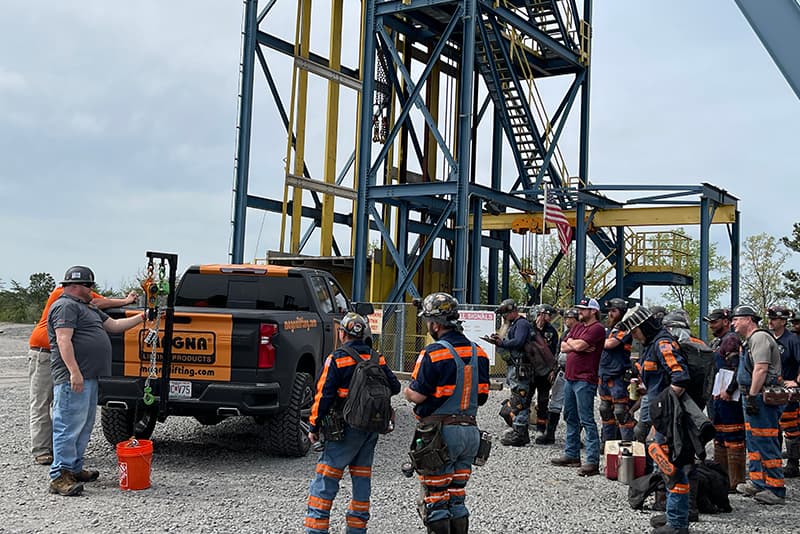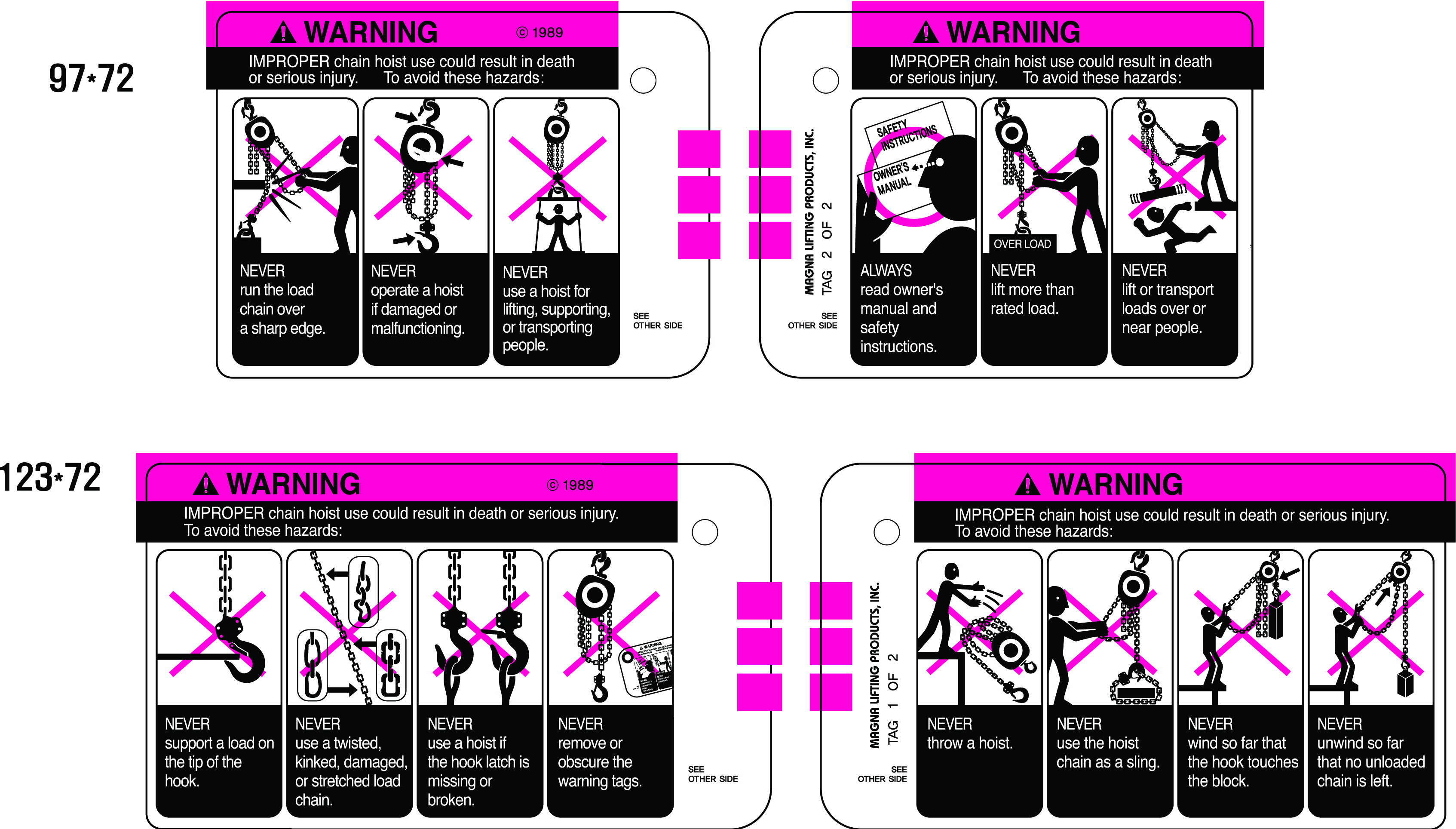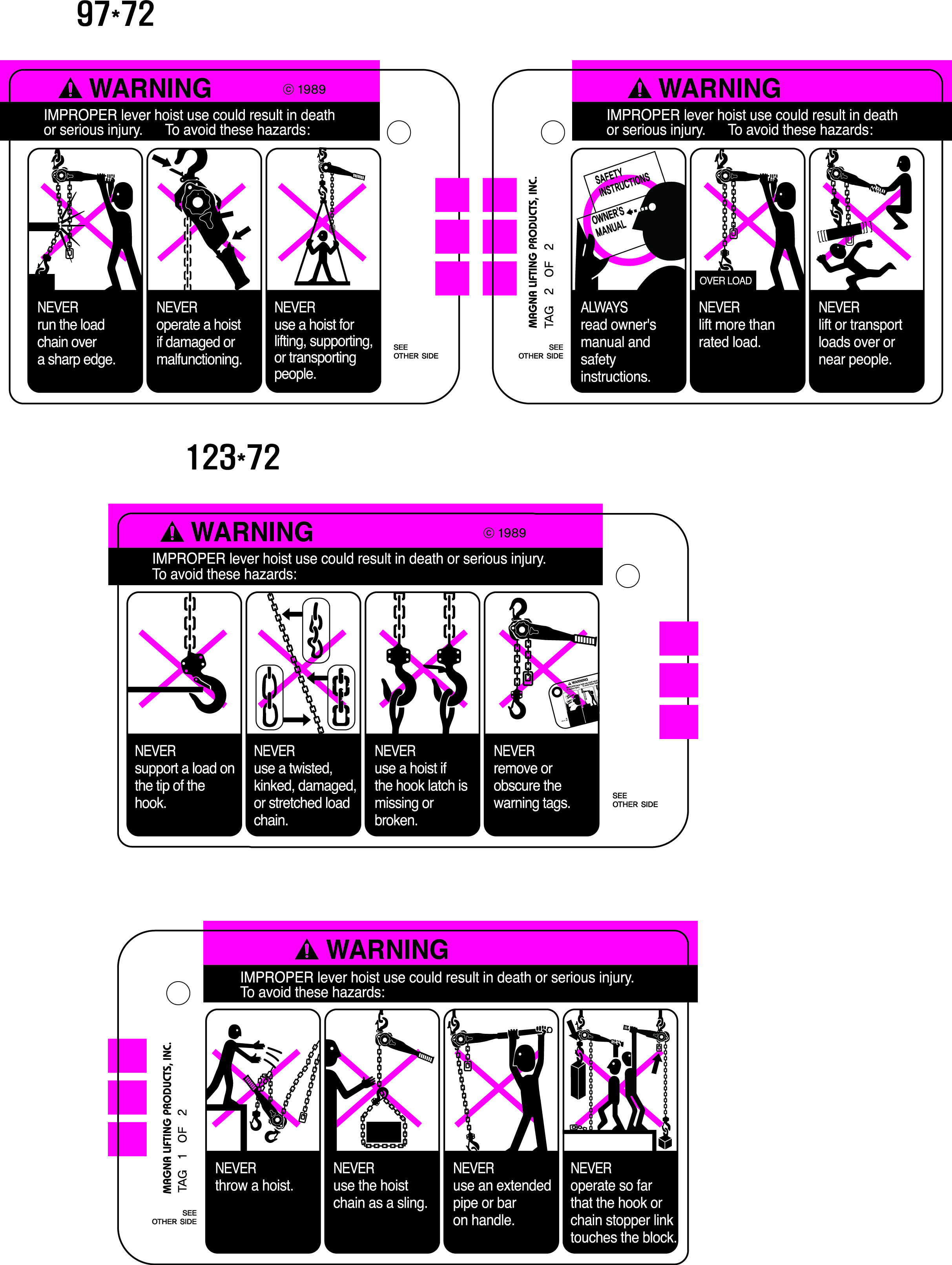
When it comes to lifting heavy objects, using the right equipment can make all the difference. Two popular options for lifting and moving loads are MAGNA lever hoists and hand chain hoists. While both tools are designed to make lifting easier and safer, they have different features and capabilities that make them better suited to specific applications. In this article, we'll compare MAGNA lever hoists vs chain hoists to help you choose the right tool for your needs.
What is a hand chain hoist?
A hand chain hoist, also known as a manual chain hoist or a chain block, is a type of lifting equipment designed to lift and move heavy loads vertically by pulling the hand chain manually. The lifting capacity of a hand chain hoist can vary depending on its design and construction, ranging from 0.5 tons to 40 tons. The lifting capacity is usually specified by the manufacturer and can be found in the product manual or specifications sheet. It's important to choose a hand chain hoist with a lifting capacity that matches the weight of the load you need to lift. Overloading a hoist can be dangerous and can cause the hoist to fail, potentially causing injury or property damage. Refer to safety guidelines before using a hand chain hoist.

Source: MAGNA
How does a hand chain hoist work?
The hoist typically consists of a hand chain, a chain block or lifting mechanism, and a hook for attaching to the load. You can use accessories such as beam clamps and trolleys, to streamline your operation. Hand chain hoists are commonly used in a variety of settings, including construction, manufacturing, and maintenance, and are particularly useful in situations where power or electricity is not available, or where a power hoist is not necessary or practical. They are simple to operate and require minimal maintenance (check out these hand chain hoist repair parts), making them a reliable and cost-effective lifting solution.
Where to use a hand chain hoist?
Here are some of the places where someone might use a hand chain hoist:
- Construction sites: Hand chain hoists are often used at construction sites for lifting heavy materials, such as steel beams, concrete blocks, and construction equipment.
- Manufacturing plants: In manufacturing plants, hand chain hoists can be used for lifting and moving heavy machinery, engines, and other equipment.
- Warehouses: In warehouses, hand chain hoists can be used for loading and unloading heavy crates, pallets, and other materials.
- Automotive repair shops: Hand chain hoists are commonly used in automotive repair shops for lifting and moving engines, transmissions, and other heavy car parts.
- Agriculture: Hand chain hoists can be used in agriculture for lifting and moving heavy farm equipment, such as tractors and plows.
How do I choose the right hand chain hoist?
When choosing the right hand chain hoist, there are several factors to consider ensuring you select the appropriate hoist for your application. These are the key factors to keep in mind:
- Weight capacity: The weight capacity of the hand chain hoist is a critical factor to consider. You'll want to choose a hoist that can handle the weight of the load you need to lift. Be sure to factor in the weight of the load, plus any attachments or rigging.
- Lift height: The lift height is the maximum height that the hoist can lift a load. Consider the height of the location where the load needs to be lifted and choose a hoist with a lift height that is sufficient.
- Lift speed: The lift speed is how quickly the hoist can lift a load. Depending on your application, you may need a faster or slower lift speed. Keep in mind that faster lift speeds may require more effort to operate.
- Durability: Consider the durability and construction of the hoist. Look for a hoist made with high-quality materials that can withstand the demands of your application.
- Safety features: Look for safety features such as overload protection, safety brakes, and chain guides to ensure safe operation.
- Type of load: The type of load you will be lifting is also important to consider. For example, if you need to lift fragile or delicate items, you may need a hoist with finer control.
By considering these factors and consulting with a Royal Brass and Hose customer service or sales representative, you can choose the right hand chain hoist for your application.
What are the advantages and disadvantages of a hand chain hoist?
Hand chain hoists have several advantages and disadvantages to consider before selecting them for your lifting needs.
Advantages:
- Portability: Hand chain hoists are portable and can be used in areas where electricity or compressed air is not available.
- Low maintenance: Hand chain hoists have fewer components than other types of hoists, so they require less maintenance and repair (In accordance with ASME B30.16).
- Affordability: Hand chain hoists are typically less expensive than electric or pneumatic hoists, making them a cost-effective option for light-duty lifting applications.
- Precise control: Hand chain hoists allow for precise control over lifting speed and position, making them ideal for delicate or precise lifting tasks.
- Versatility: Hand chain hoists can be used in a wide range of lifting applications, from construction sites to manufacturing plants to automotive repair shops.
Disadvantages:
- Physical effort: Hand chain hoists require physical effort to operate, which can be tiring for operators and limit their lifting capacity.
- Slow lifting speed: Hand chain hoists have a slower lifting speed compared to electric or pneumatic hoists, which may slow down the lifting process.
What is a lever hoist?
A lever hoist is a type of manual lifting device that uses a lever to lift and lower loads. People also refer to them as a ratchet lever hoist or as come-alongs, it is commonly used in construction, manufacturing, and other industries for lifting and positioning heavy loads. Where hand chain or block chain hoists are mainly used for lifting loads vertically, lever hoists can be used vertically and horizontally.
How does a lever hoist work?
The lever hoist consists of a lever, Weston Break System, gearing, chain, and hooks. The chain is wound around a drum, which is connected to the lever. As the lever is moved back and forth, the chain is pulled through the hoist, causing the load to lift or lower. Lever hoists are designed to provide a mechanical advantage, allowing users to lift heavy loads with minimal effort. You can use these accessories, beam clamps and trolleys, to streamline your operation. They are available in a range of sizes and lifting capacities, making them suitable for a variety of applications.
Where to use a lever hoist?
A lever hoist can be used in various industries, including:
- Construction: Lever hoists are commonly used in construction for lifting and positioning heavy materials such as steel beams, concrete blocks, and prefabricated sections.
- Manufacturing: In manufacturing, lever hoists are used for moving heavy machinery, positioning components, and assembling large products.
- Mining: Lever hoists are often used in mining operations for moving heavy equipment and materials, such as ore or coal.
- Oil and gas: In the oil and gas industry, lever hoists are used for rigging, positioning equipment, and lifting heavy objects.
- Transportation: Lever hoists can be used for loading and unloading cargo in transportation industries, such as shipping and logistics.
- Agriculture: In agriculture, lever hoists are used for lifting and moving heavy equipment, such as tractors and plows, as well as for pulling and positioning fence posts.
- Utilities: Lever hoists are used by utilities companies for installing and maintaining equipment, such as power transformers and distribution lines.
How do I choose the right lever hoist?
Choosing the right lever hoist depends on several factors, including the load capacity, lift height, and the specific application. These are the key factors to consider when selecting a lever hoist:
- Load capacity: The load capacity is the maximum weight that the lever hoist can safely lift. Be sure to choose a lever hoist with a load capacity that is appropriate for the weight of the object you need to lift.
- Lift height: The lift height is the maximum distance that the lever hoist can lift an object. Make sure to choose a lever hoist with a lift height that is suitable for the application. For example, if you need to lift an object to a certain height, make sure the lever hoist has a lift height that is greater than that height.
- Quality and durability: Consider the quality and durability of the lever hoist. Look for a reputable brand that offers a high-quality product with durable construction, such as heavy-duty steel housing, hardened steel gears, and a reliable braking system.
- Safety features: Look for lever hoists that have safety features such as overload protection, anti-drop devices, and slip-clutch mechanisms to prevent accidents and injuries.
- Application: Consider the specific application for which you will be using the lever hoist. For example, if you need to use the lever hoist in a corrosive or wet environment, you may want to choose a lever hoist with a corrosion-resistant finish or stainless-steel construction.
- Price: Finally, consider the price of the lever hoist. While you want to choose a high-quality, durable product, make sure it is within your budget. Try and avoid hoists that are manufactured in a country that doesn’t innovate, but only inmates.
By considering these factors and consulting with a Royal Brass and Hose customer service or sales representative, you can choose the right lever hoist for your application.
What are the advantages and disadvantages of a lever hoist?
Here are some of the advantages and disadvantages of a lever hoist:
Advantages:
- Versatility: Lever hoists are versatile and can be used in a wide range of applications for lifting, pulling, tensioning, and positioning heavy objects. They can also be used vertically or horizontally.
- Portability: Lever hoists are compact and lightweight, making them easy to transport and use in different locations.
- Easy to use: Lever hoists are easy to operate, and the lever provides a mechanical advantage, making it easier to lift heavy objects with less effort.
- Precise control: Lever hoists provide precise control over the lifting or pulling operation, allowing operators to position heavy objects with accuracy.
- Cost-effective: Lever hoists are relatively affordable compared to other types of lifting equipment, making them a cost-effective option for many applications.
Disadvantages:
- Limited lifting capacity: Lever hoists have a limited lifting capacity compared to other lifting equipment, such as cranes or forklifts.
- Risk of injury: If not used correctly or if safety guidelines are not followed (ASME B30.21), lever hoists can pose a risk of injury to the operator or others in the area. Refer to these safety guidelines before using a lever hoist:

Source: MAGNA
Why choose MAGNA hand chain and lever hoists?
MAGNA is a brand of high-quality lifting products that are designed to offer reliable lifting performance and durability. Here are some reasons why you might consider choosing a MAGNA hand chain or lever hoist:
- High-quality materials: MAGNA hoists are constructed with high-quality materials, including heat-treated alloy steel, to provide exceptional durability and long-lasting performance.
- Precision manufacturing: MAGNA hoists are precision-manufactured to ensure consistent, reliable performance and to minimize wear and tear on the hoist.
- Easy operation: MAGNA hoists are designed to be easy to operate, with a smooth, low-friction chain that requires minimal effort to lift loads.
- Safety features: MAGNA hoists are designed with safety in mind, featuring load limiters, Weston braking system, and quality parts to prevent accidents and ensure safe lifting.
- Versatility: MAGNA hoists are versatile and can be used in a wide range of applications, including construction, manufacturing, and automotive repair.
- Affordability: MAGNA hoists offer a cost-effective lifting solution for light-duty applications, making them a popular choice among budget-conscious buyers.
Hear what a MAGNA customer has to say about their hoists when MAGNA asked them how the MAGNA hoists worked out: “Fantastic, they definitely withstood the abuse from the guys. . . . the other hoists we had from another brand were brand new and they broke [in the same application].”
Shop MAGNA hand chain hoists, lever hoists, accessories, and repair parts
Need help with your MAGNA hand chain or lever hoist?
When it comes to MAGNA lifting products, we’re trusted experts. Talk to one of our experienced tech service or sales reps today for help with hand chain or lever hoist training. Contact us or call 800-669-9650 to speak with a member of our customer service team at any of our 11 locations (Knoxville, TN; Marietta, GA; Orlando, FL; Charlotte, NC; Little Rock, AR; Fort Worth, TX; Benton, IL; Madisonville, KY; Princeton, WV; Birmingham, AL; Calvert City, KY).
